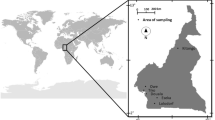Abstract
The activity concentrations of 226Ra and 228Ac in weathered Japanese soils from two selected prefectures have been measured using a γ-ray spectroscopy system with high purity germanium detector. The uranium, thorium, and rare earth elements (REEs) concentrations were determined from the same soil samples using inductively coupled plasma mass spectrometry (ICP-MS). For example, granitic rocks contain higher amounts of U, Th, and light REEs compared to other igneous rocks such as basalt and andesites. Therefore, it is necessary to understand the interaction between REEs and nature of soils since soils are complex heterogeneous mixture of organic and inorganic solids, water, and gases. In this paper, we will discuss about distribution pattern of 238U and 232Th along with REEs in soil samples of weathered acid rock (granite) collected from two prefectures of Japan: Hiroshima and Miyagi.
Similar content being viewed by others
References
Byrne, R.H., and E.R. Sholkovitz (1996), Marine chemistry and geochemistry of the lanthanides. In: K.A. Gschneidner, Jr., and L. Erying (eds.), Handbook on the Physics and Chemistry of Rare Earths, Vol. 23, Elsevier, New York, 497–593.
Field, M.P., and R.M. Sherrell (1998), Magnetic sector ICPMS with desolvating micronebulization: interference-free subpicogram determination of rare earth elements in natural samples, Anal. Chem. 70,21, 4480–4486, DOI: 10.1021/ac980455v.
Hassan, N.M., T. Ishikawa, M. Hosoda, A. Sorimachi, S. Tokonami, M. Fukushi, and S.K. Sahoo (2010), Assessment of the natural radioactivity using two techniques for the measurement of radionuclide concentration in building materials used in Japan, J. Radioanal. Nucl. Chem. 283,1, 15–21, DOI: 10.1007/s10967-009-0050-6.
Henderson, P. (ed.) (1984), Rare Earth Element Geochemistry, Elsevier, Amsterdam, 510 pp.
Masuda, A., N. Nakamura, and T. Tanaka (1973), Fine structures of mutually normalized rare-earth patterns of chondrites, Geochim. Cosmochim. Ac. 37, 2, 239–248, DOI: 10.1016/0016-7037 (73)90131-2.
McLennan, S.M. (1994), Rare earth element geochemistry and the “tetrad” effect, Geochim. Cosmochim. Ac. 58,9, 2025–2033, DOI: 10.1016/0016-7037 (94) 90282-8.
Parami, V.K., S.K. Sahoo, H. Yonehara, S. Takeda, and L.L. Quirit (2010), Accurate determination of naturally occurring radionuclides in Philippine coal-fired thermal power plants using inductively coupled plasma mass spectrometry and γ-spectroscopy, Microchem. J. 95,2, 181–185, DOI: 10.1016/j.microc.2009.11.008.
Rogers, J.J.W., and J.A.S. Adams (1969a), Thorium. In: K.H. Wedepohl (ed.), Handbook of Geochemistry, Vol. II/5, Ch. 90-E, Springer-Verlag, Berlin.
Rogers, J.J.W., and J.A.S. Adams (1969b), Uranium. In: K.H. Wedepohl (ed.), Handbook of Geochemistry, Vol. II/5, Ch. 92-E, Springer-Verlag, Berlin.
Sahoo, S.K., H. Yonehara, K. Kurotaki, K. Shiraishi, V. Ramzaev, and A. Barkovski (2001), Determination of rare earth elements, thorium and uranium by inductively coupled plasma mass spectrometry and strontium isotopes by thermal ionization mass spectrometry in soil samples of Bryansk region contaminated due to Chernobyl accident, J. Radioanal. Nucl. Chem. 247,2, 341–345, DOI: 10.1023/A:1006757718985.
Uchida, S., K. Tagami, and I. Hirai (2007), Soil-to-plant transfer factors of stable elements and naturally occurring radionuclides. (1) Upland field crops collected in Japan, J. Nucl. Sci. Technol. 44,4, 628–640, DOI: 10.1080/18811248.2007.9711851.
UNSCEAR (2000), Sources and Effects of Ionizing Radiation, United Nations Scientific Committee on the Effects of Atomic Radiation, UNSCEAR 2000 Report to the General Assembly with Scientific Annexes, Vol. I: Sources, United Nations Publications, New York, 654 pp.
Yamada, T., and Y. Nakamura (2005), Examination of the U8 type polypropylene container used for radioactivity standard volume sources, Radioisotopes 54,4, 105–110, DOI: 10.3769/radioisotopes.54.105.
Yoshida, S., Y. Muramatsu, K. Tagami, and S. Uchida (1998), Concentrations of lanthanide elements, Th, and U in 77 Japanese surface soils, Environ. Int. 24,3, 275–286, DOI: 10.1016/S0160-4120(98)00006-3.
Author information
Authors and Affiliations
Corresponding author
Rights and permissions
About this article
Cite this article
Sahoo, S.K., Hosoda, M., Prasad, G. et al. Naturally occurring radionuclides and rare earth elements in weathered Japanese soil samples. Acta Geophys. 61, 876–885 (2013). https://doi.org/10.2478/s11600-013-0131-3
Received:
Revised:
Accepted:
Published:
Issue Date:
DOI: https://doi.org/10.2478/s11600-013-0131-3




